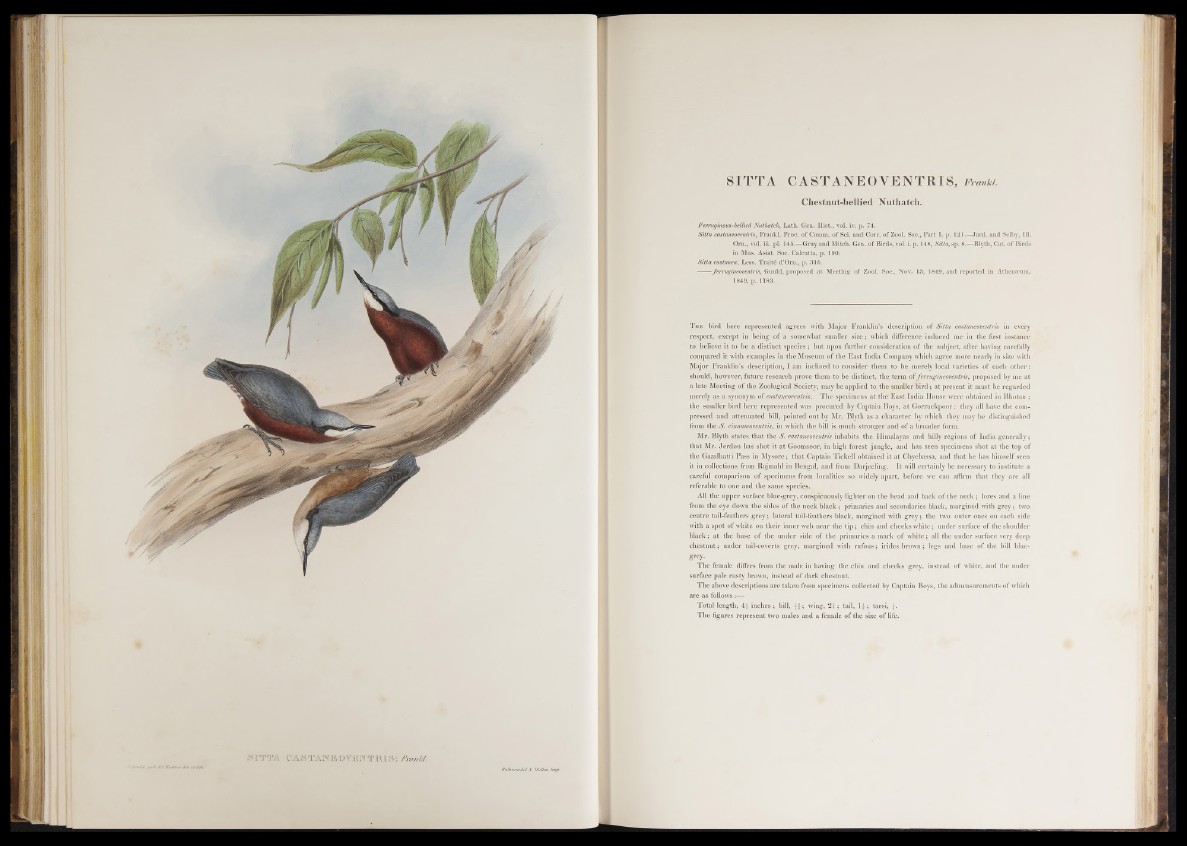
¡JTTA CASTAWJEQVENTR.IS: F m M .
S I T T A C A S T A N E O V E N T R I S , FVanki.
Chestnut-bellied Nuthatch.
Ferruginons-bellied Nuthatch, Lath. Gen. Hist., vol. iv. p. 74.
Sitta castaneoventris, Frankl. Proc. of Comm, of Soi. and Corr. of Zool. Soc., Part I. p. 121.—Jard. and Selby, 111.
Om., vol. iii. pi. 145.—Gray and Mitch. Gen. of Birds, vol. i. p. 148, Sitta, sp. 8.—Blyth, Cat. of Birds
in Mus. Asiat. Sqc. Calcutta, p. 190.
Sitta castanea, Less. Traité d’Orn., p. 316.
ferrugineoventris, Gould, proposed at Meeting of Zool. Soc., Nov. 13, 1849, and reported in Athenæum,
1849, p. 1183.
T h e bird here represented agrees with Major Franklin’s description of Sitta castaneoventris in every
respect, except in being o f a somewhat smaller size; which difference induced me in the first instance
to believe it to be a distinct species; but upon further consideration of the subject, after having carefully
compared it with examples in the Museum of the East India Company which agree more nearly in size with
Major Franklin’s description, I am inclined to consider them to be merely local varieties o f each other:
should, however, future research prove them to be distinct, the term of ferrugineoventris, proposed by me at
a late Meeting of the Zoological Society, may be applied to the smaller b ird ; at present it must be regarded
merely as a synonym o f castaneoventris. The specimens at the East India House were obtained in Bhotan ;
the smaller bird here represented was procured by Captain Boys, at Gorruckpoor: they all have the compressed
and attenuated bill, pointed out by Mr. Blyth as a character by which they may be distinguished
from the S . cinnamoventris, in which the bill is much stronger and o f a broader form.
Mr. Blyth states that the S . castaneoventris inhabits the Himalayas and hilly regions of India generally;
that Mr. Jerdon has shot it a t Goomsoor, in high forest jungle, and has seen specimens shot at the top of
tlie Gazalhatti Pass in Mysore; that Captain Tickell obtained it a t Chyebassa, and that he has himself seen
it in collections from Rajmahl in Bengal, and from Darjeeling. It will certainly be necessary to institute a
careful comparison of specimens from localities so widely apart, before we can affirm that they are all
referable to one and the same species..
All the upper surface blue-grey, conspicuously lighter on the head and back o f the n e ck ; lores and a line
from the eye down the sides of the neck black ; primaries and secondaries black, margined with g rey ; two
centre tail-feathers g rey ; lateral tail-feathers black, margined with g re y ; the two outer ones on each side
with a spot o f white on their inner web near the t ip ; chin and cheeks white; under surface of the shoulder
black ; a t the base of the under side of the primaries a mark of white; all the under surface very deep
chestnut; under tail-coverts grey, margined with rufous; irides brown; legs and base o f the bill blue-
grey.
The female differs from the male in having the chin and cheeks grey, instead of white, and the under
surface pale rusty brown, instead of dark chestnut.
The above descriptions are taken from specimens collected by Captain Boys, the admeasurements of which
are as follows:—
Total length, 44- inches ; bill, -{4; wing, 2 $ ; tail, ; tarsi, 4
The figures represent two males and a female of the size o f life.